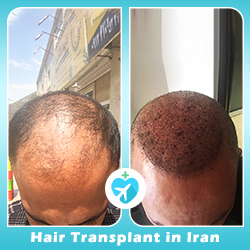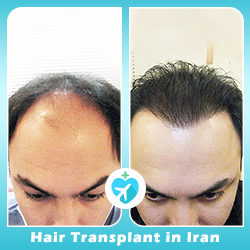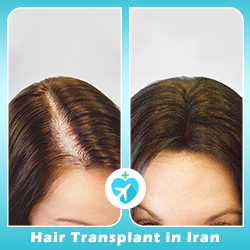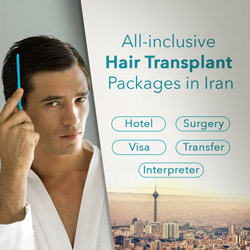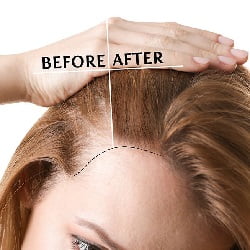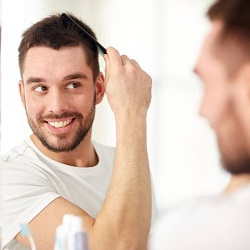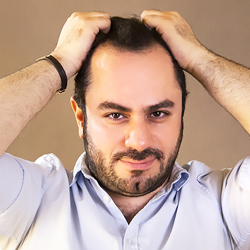Perhaps no other cosmetic surgery keeps you counting the days to see the final results more than a hair transplant.
After years of baldness, you’ve taken a big step to get your hair back — and you’ve undergone a hair transplantation procedure. While hours of lying or sitting motionless in the operating room to get your hair transplant done is tedious for sure, it’s still one day. The bigger stage lies ahead, which is recovery and hair regrowth.
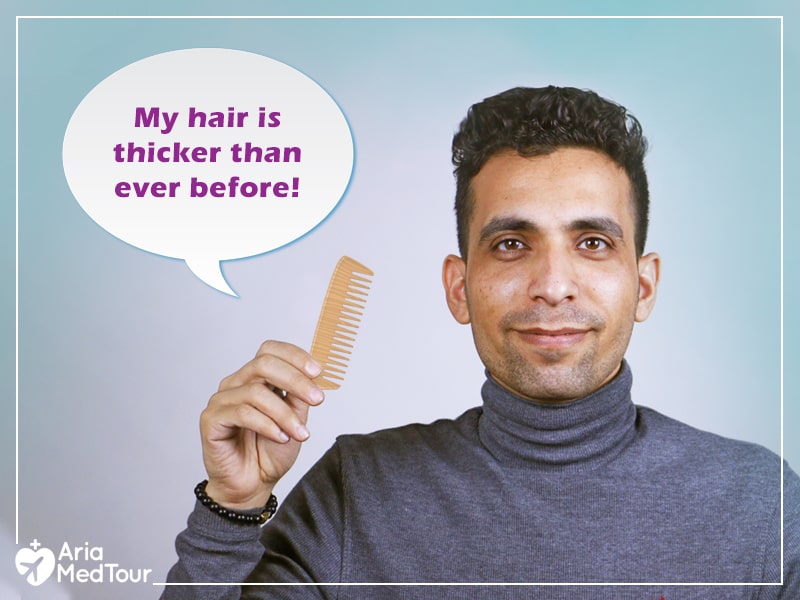
About 6 months into your hair transplantation surgery, you can enjoy a boost of confidence. In the meantime, you should make sure your recovery is effective enough.
In this article, we’re going to cover everything you need to know about recovery after hair transplant, both in its narrow sense, which is recovering from the surgery, and the wider sense, which is long-term recovery until seeing the final results.
Quick recovery tips
- Take complete rest on the first 24 hours after your hair transplant.
- Sleep with your head elevated (45-degree angle) to reduce swelling.
- Avoid alcohol and smoking for a while after surgery.
- Wash your hair once a day for 10 days, starting from 48 hours after the surgery.
- Use a baby shampoo or the shampoo recommended by your surgeon to wash your hair.
- Avoid alcohol, nicotine, and aspirin for some time after surgery.
- Avoid strenuous activity and sexual intercourse for 10-14 days after surgery.
- Do not touch or scratch your transplanted area, including when washing your hair.
- Follow a diet rich in protein, vitamins, iron, zinc, and omega-3 amino acids.
- Be patient; recovery and hair growth takes time. You may lose all your transplanted hairs suddenly in a few weeks but new hairs will grow in their place.
Hair transplant recovery timeline
Week 1
The first week after a hair transplant is very important for a proper recovery. Generally, patients are recommended to leave their heads alone during the first days and not touch their newly transplanted site.
Playing with the transplanted hairs could dislodge the grafts and it may lead to infection in the surgical area.
You are also supposed to sleep on your side or back with your head elevated in the first 2-3 days following the procedure to prevent swelling. You can use a few pillows to keep the torso in a 45-degree inclination while sleeping or sleep in a reclining chair.
There might be mild pain and discomfort in the first week, which can be relieved with pain medications. It is normal to have some swelling during this period. Mild scabbing is also normal and it usually disappears in the second week.
Avoid alcohol and any medications containing aspirin for 3-5 days following the surgery because they slow down healing and increase the risk of bleeding.
Day 1 (surgery day)
Depending on whether you had FUE or FUT hair transplant, what you expect on the first day is different.
If you had an FUE hair transplant, the back and sides of your head (donor area) have been probably shaved and there are tiny incisions there, which will heal in less than 48 hours. If you had your hair transplant done with FUT (strip harvest) method, the linear incision made in the donor area is closed with sutures.
You will be discharged from the clinic with bandages wrapped around your head. Your doctor may instruct you to remove them at home or ask you to visit the clinic for their removal the next day. The clinic will give you a post-op care package that includes the necessary items for aftercare and instructions.
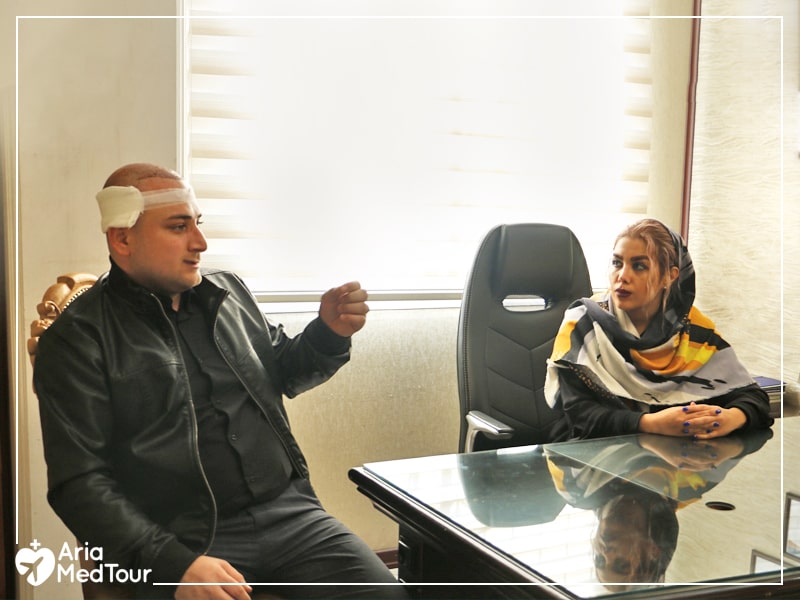
Your doctor may instruct you to remove the bandages at home or ask you to visit the clinic for their removal the next day.
It is recommended that you rest well and refrain from any activity as soon as you get home after surgery. Since you’ll be given pain medications, you’re not supposed to drive after the surgery, so bring someone with you to help you get home after being discharged from the clinic.
Days 2-4
There will be tiny little crusts in the transplanted site but it will become pinkish around day 4. Most of the pain will have gone by this time. But on day 2-3 swelling starts to increase, reaching its peak on day 4.
Use the cold compress included in your aftercare package to reduce the swelling and make sure to contact your doctor if you feel excessive pain. Continue to sleep with elevated head and avoid alcohol and aspirin in this stage.
You may wash your hair on day 2 or 3 after the procedures as instructed by your doctor. Use a baby shampoo or the shampoo prescribed by your doctor for washing the hair. Be careful not to scratch the transplanted area when washing. Instead, gently tap on the head with your hands and use low-pressure water to rinse the foam off. Use a soft towel to dry the head by gently putting it on the head, not rubbing it as it may dislodge the transplanted grafts.
Days 5-7
The transplanted grafts will have adapted to the scalp and can’t be easily dislodged by this time. The skin tightness in the donor area (in FUT cases) will improve but the sutures will be still in place. The scabs might be still there and you may have mild itching, which is probably a sign of healing. In FUE cases, the incisions in the donor area will have healed by this time.
You may resume most of your normal activities but it is recommended to avoid strenuous activities for 4 weeks.
If you are uncomfortable to appear in public with a shaved and crusty head, you can wear a loose-fitting hat but make sure to check with your doctor before doing so.
Weeks 2-4
In the second week after hair transplant, the scabbing and crusting disappear and the scalp becomes pink. From week 2 until week 8, the transplanted follicles enter a ‘resting phase’ (telogen phase) and the hairs start to fall out (shock hair loss). This is completely normal and it doesn’t mean that the procedure has failed. After the transplanted hairs (and sometimes other thinning hairs as well) have fallen out, new healthy hairs start to grow in their place.
By week 2, the incision in FUT patients is completely closed and the suture can be removed. If there are still some scabs on the scalp, do not try to forcibly remove them. Continue your routine hair care according to your doctor’s instructions and they will eventually come away on their own.
Some patients might notice pimples in either donor or transplanted areas. This is caused by a condition called folliculitis, which is inflammation of the follicles. Contact your clinic for help if you experience this.
Months 2-3
The first signs of final hair growth will appear in this stage with some patients noticing them earlier and some later. The hair growth looks like a fine texture at first but eventually, the hairs grow thicker and longer. Also, the scar in the donor area in FUT cases takes its final shape by this time.
Although the full thickness of the hair isn’t achieved after 3 months, you can start to groom your hair by this time.
Months 4-6
Your hair will have grown thicker and longer at this point and you have more hair-styling options. The donor site will have completely healed.
Provided that your recovery goes as planned, you even can dye your hair. At this point, 60% of your transplanted hairs would grow but you already can notice the difference.
Months 7-12
Up to 90% of the transplanted hairs will have grown by this time and now you can judge the result of your procedure.
One year onward
You’ll get the final outcome of your FUE or FUT hair transplant 12-18 months after the procedure. That said, each patient is different from another and that’s why you should regularly go for check-ups during the recovery after hair transplant to ensure that everything is going well.
Sending photos of your hair at each stage of your hair recovery to your doctor is advisable if you can’t have appointments with him/her each time.
Hair transplant aftercare tips
How to sleep after hair transplant?
It is highly recommended that you get complete rest on the first day after a hair transplant. Keep in mind that sufficient rest is vital for healing after the surgery. Use a few pillows to keep your head elevated to reduce swelling for the first 2-3 nights after surgery.
Be careful not to sleep on your stomach as the transplanted area might get rubbed against the pillow and the grafts might get dislodged. Sleeping on your back or sides is the recommended sleeping position after hair transplant.
How to wash my hair after hair transplant?
It is crucial to keep your hair clean after your hair transplant by regularly washing your hair because poor hair and scalp hygiene may result in serious problems, including pilonidal cysts and pimples on the scalp. Meanwhile, the freshly-transplanted hairs are not as strong as your natural hairs, so extra caution should be taken when washing the hair.
Washing hair after hair transplant should be done as instructed by your surgeon. But the basics of the process are usually as follows:
Typically, you can start washing your hair or showering 48 hours after the procedure. The surgeon usually prescribes special shampoos and lotions, which may be included in an aftercare package given to you after the procedure.
The best shampoo for washing your hair after hair transplant is prescribed by your surgeon based on the level of greasiness of your hair, and the PH, composition, and antioxidation of the shampoo. Using baby shampoo is also a good option because it doesn’t contain harmful chemicals.
The washing process consists of 3 steps:
- Gently apply the lotion on the transplanted area, wait for 40 minutes (20 minutes for the next sessions) and rinse the head with low-pressure lukewarm water.
- Gently apply baby shampoo or the prescribed foam-like shampoo on the area, wait for 3 minutes and rinse the foam off with low-pressure lukewarm water.
- Dry your head with a soft towel or a few tissues. Gently press the towel or tissues on the head to absorbs some of the excess water and wait until the head completely drys on its own. Do not use a hairdryer.
Some general instructions for washing hair after hair transplant are as follows:
- Do not let the flow of water hit your transplanted area directly. Use your hands against your head to reduce the pressure of the flow of water when showering.
- Rubbing or scratching your scalp while washing your hair is strongly forbidden as it knocks the transplanted hairs out of position. Use gentle tapping movements to apply foam or lotion on the scalp.
- Do not use a hairdryer to dry your hair after the wash. Gently put a soft towel on the head to absorbs some of the excess water and leave the head to completely dry on its own.
- You may want to gently massage the donor area with your fingers while washing your hair to stimulate blood circulation. Do not do this for the recipient area.
- Use these special instructions for 10-14 days after your hair transplant (one wash per day) and then you can resume your regular washing routine.
How to reduce swelling after hair transplant?
To address the swelling in your forehead area after hair transplant, take the following tips.
- Sleep with your head elevated at a 45-degree angle for the first 2-3 days after the hair transplantation procedure.
- Apply a cold compress on your forehead the first night after the procedure. You can do this every 1-2 hours for 20 minutes. Do not do this if you suffer from sinusitis. Do not hold the compress on your head for too long.
- Do not eat ice cream and avoid alcohol and aspirin-containing medicines for 3-5 days.
What to avoid after hair transplant?
Smoking
Avoid cigarettes and any products that contain nicotine as they are bad for your healing after hair transplant. Smoking is also bad for hair follicles and may increase hair loss. It is recommended that you stop smoking from 10 days before until 2 weeks after your hair transplant.
Exercise
Any activity (however light) should be avoided for the first day. During the next 10-14 days, it is recommended to avoid any exercise and strenuous activity.
Sun exposure
Try to avoid staying in the sun for too long during the first few weeks after your hair transplant as sun exposure can delay the healing process.
Wearing hats
Wearing hat after the hair transplant can damage and dislodge the newly-planted grafts. Wearing hats can also cause sweating, which is bad for the transplanted hairs. Avoid wearing any hats after hair transplant in the first few days and if you need to cover your head when appearing in public, wear a loose-fitting hat at least 5 days after the procedure with the approval of your doctor.
Sexual intercourse
It is advisable to refrain from sexual intercourse for 10 days following hair transplantation surgery. Having gentle sexual activity isn’t an issue as long as your hair isn’t touched by your partner or rubbed against something.
What are the potential complications of a hair transplant?
You rarely experience major complications during your recovery after a hair transplant. The common side effects of hair transplant are swelling, bruising, bleeding, scabbing, itching, numbness or lack of sensation, inflammation of hair follicles (folliculitis), infection, shock loss (explained above), and unnatural-looking tufts of hair (due to the surgeon’s lack of skill).
Most of these side effects are temporary and usually disappear in a few days or weeks. It is important to report any unusual sign to your doctor and attend your follow-up appointments to have your hair checked.
As said in the previous section, swelling can be reduced by sleeping with your head elevated, applying a cold compress on your forehead, and refraining from eating ice cream and drinking alcohol.
Bleeding after a hair transplant is controlled by the bandage the surgeons applies on your head and it usually stops after 24 hours. To prevent bleeding during your hair transplant recovery, avoid alcohol and anti-inflammatory drugs such as aspirin.
Infection can be prevented by regularly washing your hair (according to the instructions provided above). Also, do not touch the surgical area as it can cause bacterial infection.
Hair transplant diet: what to eat?
Maintaining a healthy diet after hair transplantation surgery is crucial to a quick recovery and proper growth of the transplanted hairs. Generally, a good diet for hair transplant recovery is one that contains sufficient amounts of the following nutrients:
- Protein
- Iron
- Calcium
- Magnesium
- Zinc
- Vitamin B6
- Omega-3 fatty acids
You can include chicken, eggs, fish, dairy products, nuts, beans, and seeds in your diet after hair transplant to take adequate amounts of protein, which is essential for hair growth.
Seafood is also a good source of omega-3 acids, which promote hair growth. Salmon, oily fish like herring, and mackerel contain plenty of omega-3 fatty acids. If you’re a vegetarian, go for walnuts, avocado, and flax seeds.
Hair transplant recovery FAQs
When can I go back to work after my hair transplant?
You can return to work the day after hair transplant if your work doesn’t involve heavy physical activity or exposure to sun or polluted air. However, it is recommended that you take 4-5 days off to rest well after the procedure. The better the post-operative care after hair transplant, the faster the healing and the better the results.
Why are my transplanted hairs falling out?
This is normal. The transplanted hairs usually fall out at a point between the second and eighth months after the surgery due to the natural hair growth cycle. In this stage, the hair follicles enter a resting phase, and after a while (2-3 months after surgery) new hairs start to grow.
What are the medications I need to take after a hair transplant?
Depending on different factors, your surgeon prescribes some medications and supplements for you. They include antibiotics (such as Cephalexin), pain killing medications, anti-inflammatory drugs, vitamin and iron supplements, minoxidil, and so on.
Can I remove the bandage on my own?
It is advisable to leave the bandage removal to your clinic if possible. If you can’t go back to the clinic, you can remove the bandage yourself at home according to the instructions given by your clinic or surgeon.

